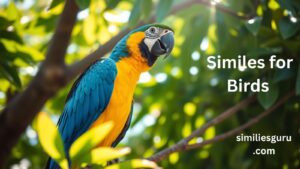Poetry is a wonderful way for kids to engage with language, stimulating their imaginations and helping them understand the nuances of words. One of the most exciting aspects of poetry is the use of literary devices, particularly similes and metaphors. These tools help poets convey vivid imagery and emotions, turning simple descriptions into captivating pieces of art. Whether you’re teaching young learners about the power of words or simply looking for some creative inspiration, poems with similes and metaphors are a perfect choice.
In this article, we’ll explore over 25 poems that are rich with these literary devices. We’ll also highlight various polite, professional, and casual alternatives to the phrase “poems for kids with similes and metaphors,” giving you the flexibility to express this idea in different contexts.
What Are Similes and Metaphors?
Before we dive into the poems, let’s briefly define the two key literary devices:
- Similes: A simile is a figure of speech that compares two different things using the words “like” or “as.” It helps create vivid pictures in the reader’s mind by drawing parallels between the familiar and the unfamiliar. For example, “as brave as a lion” or “as bright as the sun.”
- Metaphors: A metaphor is a figure of speech that directly compares two different things by stating that one thing is another. It’s often used to describe something in a more imaginative way. For instance, “the classroom is a zoo” or “time is a thief.”
Both similes and metaphors help bring poetry to life, making the ordinary extraordinary and the abstract concrete.
25+ Poems for Kids with Similes and Metaphors
1. The Sun and the Moon
Simile: “The moon is like a silver coin.”
This poem compares the moon to a coin, emphasizing its brightness and roundness.
2. The Busy Bee
Metaphor: “The bee is a tiny soldier, guarding the flowers.”
Here, the bee is described as a soldier, highlighting its diligent and hardworking nature.
3. A Day at the Beach
Simile: “The waves crash like thunder.”
The power of the ocean is compared to thunder, invoking a sense of strength and sound.
4. The Rainbow’s Promise
Metaphor: “The rainbow is a bridge in the sky.”
This metaphor transforms the rainbow into a magical bridge, symbolizing a connection between earth and heaven.
5. The Little Cloud
Simile: “The cloud is as fluffy as cotton candy.”
A gentle comparison to cotton candy brings a soft, light image to the cloud.
6. The Stubborn Oak
Metaphor: “The oak tree is a wise old man.”
By comparing the tree to a wise old man, this metaphor suggests experience and longevity.
7. The Night Sky
Simile: “The stars twinkle like diamonds.”
Stars are compared to diamonds to emphasize their sparkle and preciousness.
8. The Racing Wind
Metaphor: “The wind is a fast runner.”
This metaphor gives the wind human-like qualities, suggesting speed and agility.
9. The Singing Bird
Simile: “The bird’s song is like a melody in the wind.”
The sound of the bird’s song is compared to a melody, making it sound musical and sweet.
10. The Curious Kitten
Metaphor: “The kitten is a little detective, exploring every corner.”
This metaphor personifies the kitten as a detective, suggesting curiosity and investigation.
11. The Mighty Mountain
Simile: “The mountain is as tall as the sky.”
The height of the mountain is exaggerated in a way that suggests it reaches into the heavens.
12. The Floating Feather
Metaphor: “The feather is a gentle kiss from the sky.”
This metaphor emphasizes the soft and delicate nature of the feather, associating it with a tender gesture.
13. The Thunderstorm
Simile: “The thunder rumbles like a giant’s growl.”
Thunder is compared to the growl of a giant, creating an image of power and intimidation.
14. The Silent Forest
Metaphor: “The forest is a whispering world of secrets.”
This metaphor gives the forest an air of mystery, as though it holds hidden stories.
15. The Fast River
Simile: “The river runs like a racecar down the hill.”
The speed of the river is compared to a racecar, emphasizing its rapid movement.
16. The Lonely Cloud
Metaphor: “The cloud is a lonely traveler in the sky.”
The cloud is personified as a lonely traveler, suggesting solitude and drifting.
17. The Shiny Apple
Simile: “The apple is as red as a rose.”
The apple’s color is compared to the deep red of a rose, suggesting vibrancy and freshness.
18. The Playful Pup
Metaphor: “The puppy is a ball of energy, always bouncing around.”
The puppy is compared to a ball, showing its energetic and playful nature.
19. The Gentle Rain
Simile: “The rain falls like soft whispers on the roof.”
The rain is described as gentle and soothing, like whispers, creating a calming image.
20. The Busy Ants
Metaphor: “The ants are tiny workers, marching in line.”
This metaphor emphasizes the ants’ industrious nature by comparing them to hardworking individuals.
21. The Silent Moon
Simile: “The moon is as quiet as a sleeping baby.”
The stillness of the moon is compared to the peacefulness of a sleeping child.
22. The Starry Night
Metaphor: “The stars are little diamonds scattered across the sky.”
Stars are compared to diamonds, emphasizing their brilliance and beauty.
23. The Gentle Breeze
Simile: “The breeze is as cool as a breath of fresh air.”
The breeze is compared to the refreshing sensation of taking a deep, cool breath.
24. The Busy City
Metaphor: “The city is a buzzing hive of activity.”
The city is compared to a hive, suggesting constant movement and energy.
25. The Colorful Garden
Simile: “The flowers are as bright as a painter’s palette.”
The flowers are described as vibrant and colorful, like a palette filled with bright paints.
Polite, Professional, and Casual Alternatives to the Phrase “Poems for Kids with Similes and Metaphors”
In professional writing, the phrase “poems for kids with similes and metaphors” can be reworded in a variety of ways. Here are some alternatives based on tone:
- Polite/Professional Alternatives
- “Children’s poetry featuring similes and metaphors.”
- “Engaging poems for young readers with literary devices.”
- “Creative poems for kids using similes and metaphors.”
- “Children’s poetry featuring similes and metaphors.”
- Casual Alternatives
- “Fun poems for kids with similes and metaphors.”
- “Poems for kids that make use of similes and metaphors.”
- “Cool poems for kids with awesome similes and metaphors.”
- “Fun poems for kids with similes and metaphors.”
These alternatives allow flexibility in tone, depending on the context of your writing.
8 User-Friendly Texting Examples
- “Hey, check out these cool poems for kids with similes and metaphors!”
- “I found some really fun poems with similes and metaphors for the kids.”
- “These poems for kids are filled with similes and metaphors—so imaginative!”
- “Kids will love these poems that use similes and metaphors to create amazing pictures.”
- “Ever read poems for kids with metaphors? They make the words come alive!”
- “Poems for kids don’t get much better than those with similes and metaphors.”
- “Here’s a list of poems for kids that are packed with similes and metaphors!”
- “These poems use similes and metaphors to make the stories feel magical.”
Conclusion
Similes and metaphors are powerful literary tools that bring poetry to life, especially in children’s poems. By using these devices, poets can create vivid images and emotional connections, helping young readers engage with language in exciting and meaningful ways. The poems in this article serve as an excellent starting point for exploring these literary devices, and the alternatives for expressing “poems for kids with similes and metaphors” allow for versatile expression in various contexts.



